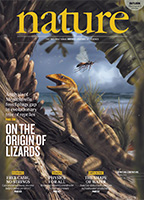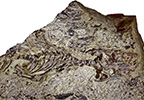
 |
Megachirella wachtleri - The history of discovery
In 1999, Michael Wachtler recovered a partially preserved reptile-skeleton from the Kühwiesenkopf (Prà della Vacca) in the Pragser Dolomites. It was described by Silvio Renesto and Renato Posenato in 2003 as Megachirella wachtleri. Immediately, the importance of this fossil was recognized as pertaining to the crown group of squamata and also the lepidosauromorpha. But only in 2018, a group of scientists under the overall control of Tiago Simōes were able to classify Megachirella wachtleri as the oldest known stem squamate.
The small-sized slab lies between the fragments of cycads, ferns and conifers. Only some rib fragments were observable in the beginning, the other remained hidden under the covering marl. Unfortunately, the second part of the slab holding a part of the back, the hind-limbs, and the tail remained enclosed in the rocks, and due to the fact that Wachtler was forbidden future research, this persisted till the present.
The small slab was handed to the fossil vertebrate-specialist Silvio Renesto, who made, in 2003, a first publication with Renato Posenato, naming the reptile Megachirella (for Mega (large) cheiros (hand): little animal with large hand, referred to the shape and robustness of the manus) and dedicated it to Wachtler who discovered the specimen.
In 2018, a group of researchers, including Michael W. Caldwell, Mateusz Tałanda, Oksana Vernygora, Massimo Bernardi, Alessandro Palci, Federico Bernardini, Lucia Mancini, Randall L. Nydam, and led by Tiago Simões published ‘The origin of squamates revealed by a Middle Triassic lizard from the Italian Alps’ and concluded the last big step.
In a research letter published in the journal ‘Nature’, with the cover image made by the Italian paleo-artist Davide Bonadonna, they were able to summarize: ‘Megachirella provides unique insights into the early acquisition of squamatan features, as it is the first unequivocal squamate from the Triassic.’
After the finding and the first description of Renesto and Posenato in 2003, Wachtler was involved in juristic disputes regarding his research for many years. Big parts of Wachtler’s collection stored in the Museum Dolomythos in Innichen were confiscated and about 5,000 objects removed and put to magazines in Bozen. Wachtler was forbidden to continue his studies regarding fossil plants and the palaeontology of the Dolomites or to take photographs of his objects.
The importance of Megachirella wachtleri - The most interesting conclusions were:
- The more than 242-million-year-old fossil, Megachirella wachtleri, is the most ancient ancestor of all modern lizards and snakes, iguanas, chameleons, geckos, known as squamates.
- Megachirella is about 75 million years older than what was thought were the oldest fossil squamata in the world.
- The CT scans revealed features that are only found together in squamates: a lower jawbone, a specific type of braincase structure, a unique collarbone, and some other small but significant details in the fossil’s limbs.
- Molecular and skeletal clues revealed that geckos lie among the earliest lizards to evolve among the modern families and that iguanians (which includes iguanas, anoles, and chameleons) are more deeply nested inside the lizard tree of life.
- It can be estimated that the origin of the major groups of reptiles indicate a much older origin than previously imagined: before the Permian-Triassic Mass extinction almost 252 million years ago.
- Megachirella wachtleri lived in a time when the last aborescent Lepidodendron lycopods - probably two m to three m high growing Lycopia dezanchei - had its last apparition on Earth and with Sigillcampeia nana also the last representatives of the Sigillaria-lycopods.
- Gymnosperms like many conifer-families and also Cycads dominated the tropical beaches where Megachirella wachtleri evolved.
- In the Permo-Triassic transition in Europe and America, no flowering plants or ancestors of them were recovered. Otherwise, many plant-tribes of the former Angara-Land (Now the Fore-Urals) evidence angiosperm- features.
- Megachirella wachtleri provided the palaeontological world with a sort of ‘Rosetta Stone’ for reptile evolution.
|




